1996 PONTIAC BONNEVILLE flat tire
[x] Cancel search: flat tirePage 2 of 387
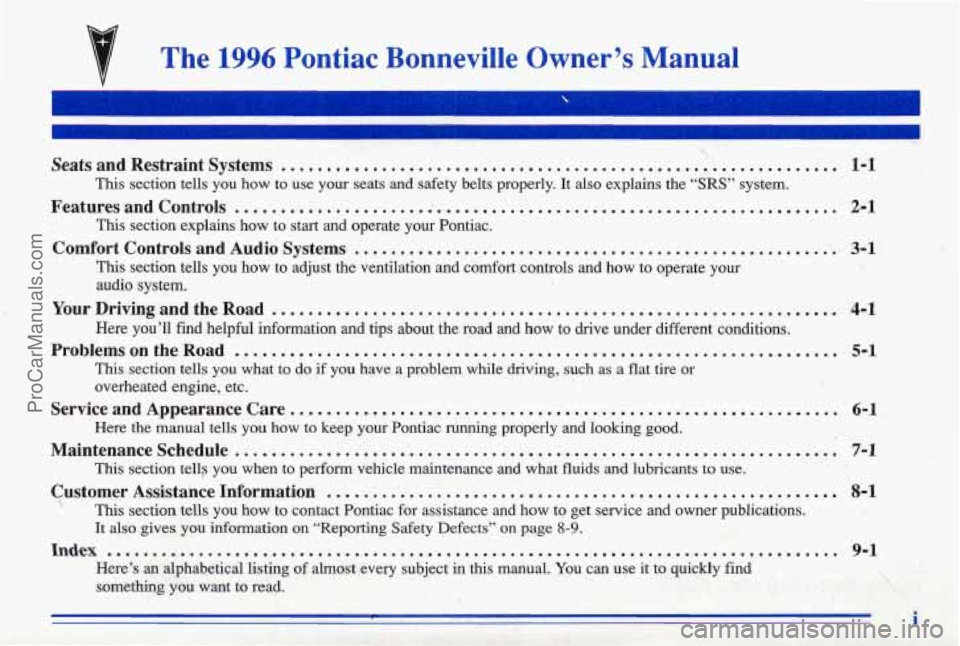
The 1996 Pontiac Bonneville Owner’s Manual
-
Seats and Restraint Systems ............................................................. 1-1
This section tells you how to use your seats and safety belts prop\
erly. It also explains the “SRS” system.
This section explains how to start and operate your Pontiac.
This section tells you how to adjust the ventilation and comfort co\
ntrols and how to operate your
audio system.
Here you’ll find helpful information and tips about the road\
and
how to drive under different conditions.
This section tells you what to do if you have a problem while driving, such as a flat tire or
overheated engine, etc.
Here the manual tells
you how to keep your Pontiac running properly and looking good.
This section tellp you when to perform vehicle maintenance and what \
fluids and lubricants to use.
This section tells you how to contact Pontiac for assistance and how to get service and \
owner publications.
It also gives you information on “Reporting Safety Defects”\
on page 8-9.
Here’s an alphabetical listing of almost every subject in this manual. You can use it to quickly find
something
you. want to read.
Features and Controls ..................... ; ............................................ 2-1
Comfort Controls and Audio Systems ...................................................... 3-1
. Your Driving and the Road .............................................................. 4-1
ProblemsontheRoad
.................................................................. 5-1
Service and Appearance Care.. .......................................................... 6-1
Maintenanceschedule......... .......................................................... 7-1
Customer Assistance Information ... .#. ................................................... 8-1
Index ........................................................................\
.......... 9-1
ProCarManuals.com
Page 105 of 387
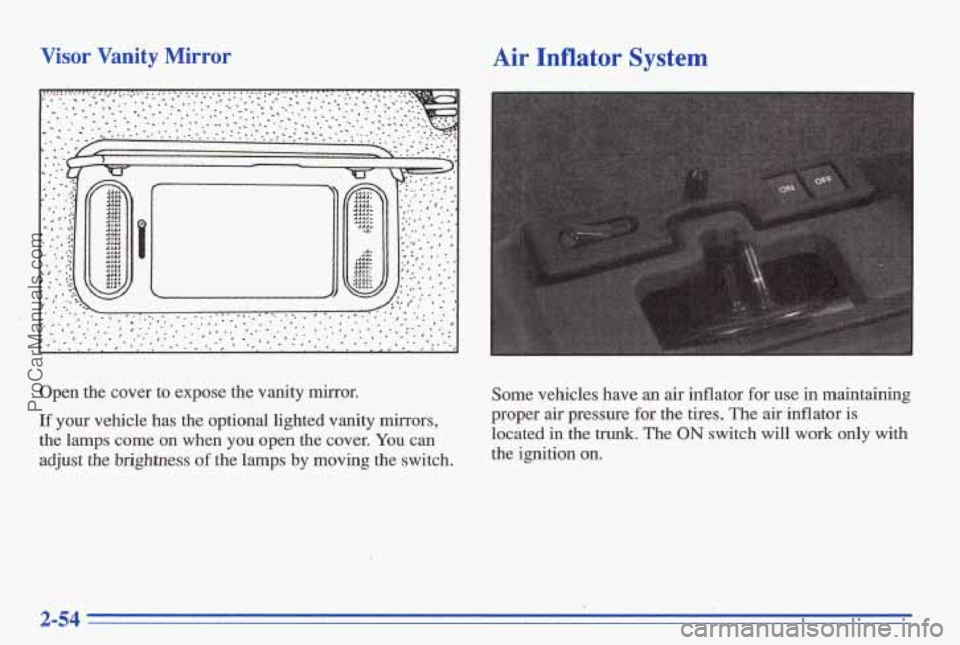
Visor Vanity Mirror Air Inflator System
Open the cover to expose the vanity mirror.
If your vehicle has the optional lighted vanity mirrors,
the lamps come on when you open the cover. You can
adjust the brightness of the lamps by moving the switch, Some vehicles have an air inflator
for use
in maintaining
proper air pressure
for the tires. The air inflator is
located in the trunk. The ON switch will work only with
the ignition
on.
ProCarManuals.com
Page 189 of 387

The exit speed is usually posted.
Reduce your speed according to
your speedometer, not
to your sense of motion. After driving for any distance
at higher speeds, you may tend
to think you are going
slower than
you actually are.
Before Leaving on a Long Trip
Make sure you’re ready. Try to be well rested. If you
. must start when you’re not fresh -- such as after a day’s
work
-- don’t plan to make too many miles that first part
of the journey. We,ar comfortable clothing and
shoes you
can easily drive in.
Is your vehicle ready for a long trip? If you keep it
serviced and maintained, it’s ready to
go. If it needs
service, have it done before starting out.
Of course,
you’ll find experienced and able service experts in
Pontiac dealers all across North America. They’ll be
ready and willing to help,if you need
it.
Here are some things you can check before a trip:
0 Windshield Washer Fluid: Is the reservoir full?
Are all windows clean inside and outside?
0 Wiper Blades: Are they in good shape?
Fuel, Engine Oil, Other Fluids: Have you checked
all levels?
0 Lamps: Are they all working? Are the lenses dean?
0 Tires: They are vitally irnportmt to a safe,
trouble-free trip.
Is the tread good enough for
long-distance driving? Are the tires
all inflated to the
recommended pressure?
0 Weather Forecasts: What’s the weather outlook
along your route? Should you delay your trip a short
time to avoid a major storm system?
Maps: Do you have up-to-date maps?
ProCarManuals.com
Page 190 of 387

Highway Hypnosis
Is there actually such a condition as “highway hypnosis”?
Or is it just plain falling asleep at the wheel? Call it
highway hypnosis, lack of awareness, or whatever.
There
is something about an easy stretch of road with the
same scenery, along with the hum of the tires on the road,
the drone of the engine, and the rush of the wind against
the vehicle that can make you sleepy. Don’t let
it happen
to
you! If it does, your vehicle can leave the road h Zess
than a second, and you could crash and be injured.
What can you
do about highway hypnosis? First, be
aware that
it can happen.
Then here are some tips:
0
a
0
Make sure your vehicle is well ventilated, with a comfortably cool interior.
Keep your eyes moving.
Scan the road ahead and to
the sides. Check your rearview mirrors and your
instruments frequently.
If you get sleepy, pull off the road into a rest, service
or parking area
and take a nap, get some exercise, or
both. For safety, treat drowsiness on the highway as
an emergency.
Hill and Mountain Roads
Driving on steep hills or mountains is different from
driving in flat or ,rolling terrain.
ProCarManuals.com
Page 197 of 387
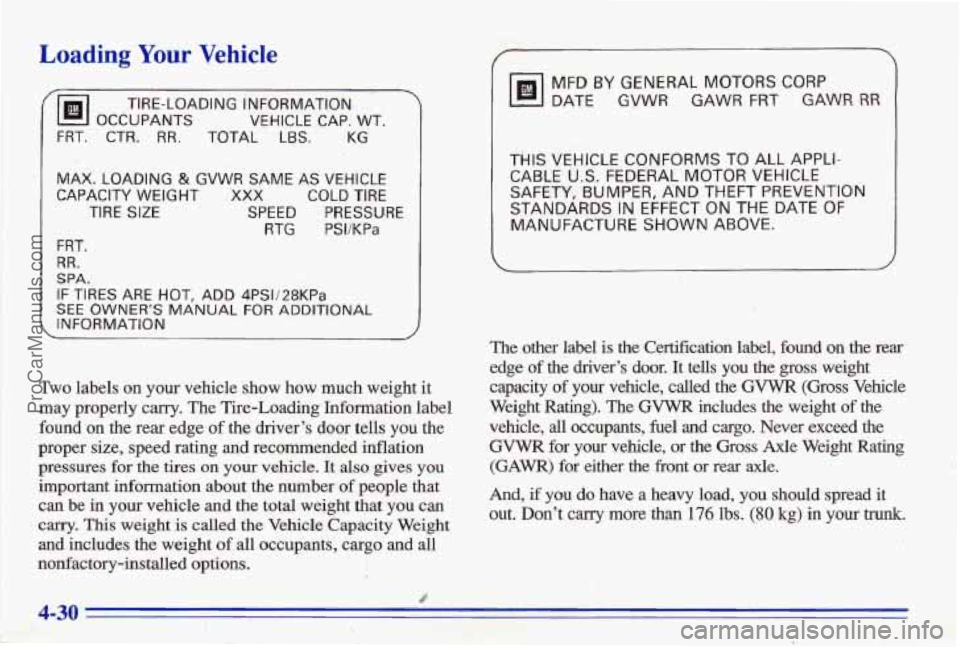
Loading Your Vehicle
'@I OCCUPANTS VEHICLE CAP. WT.
TIRE-LOADING IiNFORMATlON
FRT. CTR. RR. TOTAL LBS. KG
MAX. LOADING & GVWR SAME AS VEHICLE
CAPAC,lTY WEIGHT XXX COLD TIRE
TIRE SIZE SPEED PRESSURE
RTG PSI/KPa
FRT.
RR.
SPA.
IF TIRES ARE HOT, ADD 4PS1/28KPa
SEE OWNER'S MANUAL FOR ADDITIONAL
INFORMATION
Wo labels on your vehicle show how much weight it
may properly carry. The Tire-Loading Information label
found
on the rear edge of the driver's door tells you the
proper size, speed rating and recommended inflation
pressures
for the tires on your vehicle. It also gives you
important information about the number of people that
can be in your vehicle and the total weight that you can
carry. This weight is called the Vehicle Capacity Weight
and includes 'the weight of all occupants, cargo and all
nonfactory-installed options.
MFD BY GENERAL MOTORS CORP
DATE GYWR GAWR FRT GAWR RR
THIS VEHICLE CONFORMS TO ALL APPLI-
CABLE U.S.
FEDERAL MOTOR VEHICLE
SAFETY, BUMPER,
AND THEFT PREVENTION
STANDARDS IN EFFECT ON THE DATE OF
MANUFACTURE SHOWN ABOVE.
The other label is the Certification label, found on the rear
edge
of the driver's door. It tells you the gross weight
capacity
of your vehicle, called the GVWR (Gross Vehicle
Weight
Rating). The GVWR includes the weight of the
vehicle, all occupants, fuel and cargo. Never exceed the
GVWR for your vehicle, or the Gross Axle Weight Rating
(GAWR) for either the fi-ont or rear axle.
And, if you do have a heavy load, you should spread it
out. Don't cq more than 176 lbs: (80 kg) in your h-unk.
ProCarManuals.com
Page 201 of 387
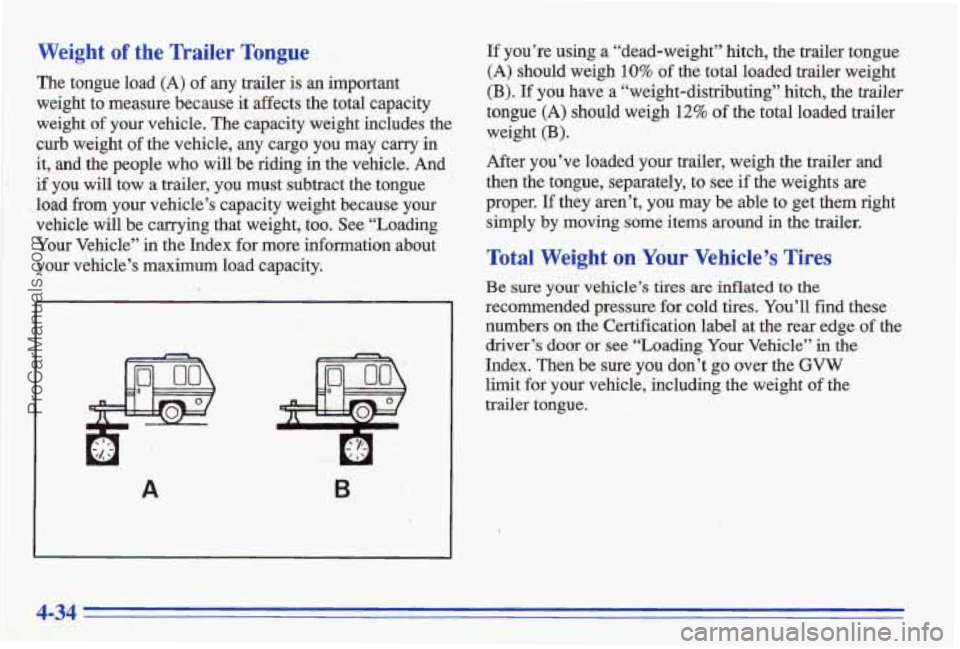
Weight of the Trailer Tongue
The tongue load (A) of any trailer’ is an important
weight to measure because it affects
the total capacity
weight
of your vehicle. The capacity weight includes the
curb weight
of the vehicle, my cargo you may carry in
it, and the people who will%e riding in the vehicle. And
if you
will tow a trailer, you must subtract the tongue
load from your vehicle’s capacity weight because your
vehicle will be carrying that weight, too. See “Loading
Your Vehicle” in the Index for more information. about
your vehicle’s maximum load capacity.
A
If you’re using a “dead-weight” hitch, the trailer tongue
(A) should weigh 10% of the total loaded trailer weight
(B). If you have a “weight-distributing” hitch, the trailer
tongue (A) should weigh 1.2% of the total loaded trailer
weight
(B).
After you’ve loaded your trailer, weigh the trailer and
then the tongue, separately, to see
if the weights are
proper. If they aren’t, you may be able to get them right
simply by
moving some items around in the trailer.
Total Weight on.Your Vehicle’s Tires
Be sure your vehicle’s tires -are inflated to the
recommended pressure for-cold tires. You’ll find these
numbers
~ltl the Certification label at the rear edge of the
drivel’s
door or see “Loading. Your Vehicle” in the
Index. Then be sure you don’t go over the GVW
limit for your vehicle, including the weight of the
trailer
tongue.
4-34
ProCarManuals.com
Page 230 of 387
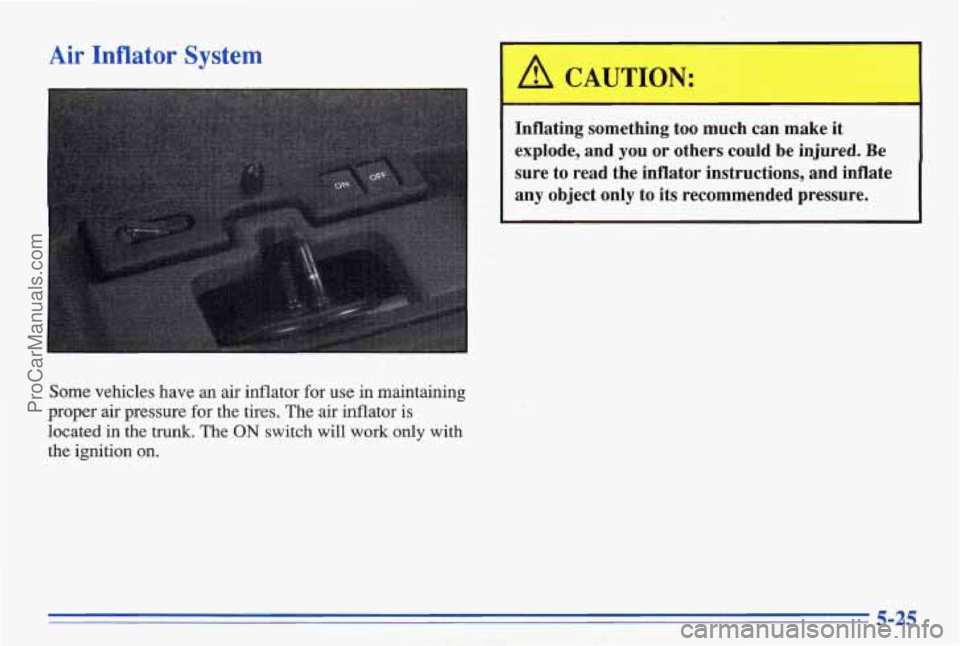
Air Inflator System
Some vehicles have an air inflator for use in maintaining
proper air pressure for the tires. The air inflator is
located
in the trunk. The ON switch will work only with
the ignition on.
A CAUTION:
Inflating something too much can make it
explode, and you or others could be injured. Be
sure to read the inflator instructions, and inflate
any object only to its recommended pressure.
5-25
ProCarManuals.com
Page 231 of 387

Changing a Flat Tire
If a tire goes flat, avoid fwther tire and wheel damage
by driving slowly to a level place, Turn on your hazard
warning flashers.
A CAUTION:
Changing a tire can cause an injury. The vehicle
can slip
off the jack and roll over you or other
people. You and they could be badly injured.
-Find a level place to change your tire. To help
prevent the vehicle from moving:
1. Set the parking brake firmly.
2. Put the shift lever in PARK (P).
3. lbrn off the engine.
To b'e even more certain the vehicle won't move,
you can put blocks
at. the front and rear of the
tire farthest away from the one being changed.
That would
be the tire on the other side of the
vehicle, at the opposite end.
The following steps will tell you how to use the jack and
c;lhange a tire.
ProCarManuals.com